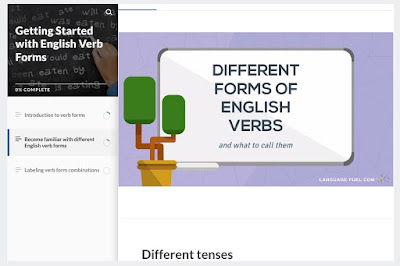Over the last few weeks, I have been looking through LanguageFuel's online courses for EL teachers.
They have a great selection of teacher development courses, around 35 at present, with some really interesting content and a great selection of different topics, that vary from basics like Using Flashcards to more complex issues like Intercultural Awareness.
The courses are ideal for short bursts of study on your laptop or mobile as they have been divided into bite-size learning tasks and input. To do a complete course takes between 15 mins and about an hour.
The main content is delivered through a mixture of text, interactive activities and animated videos which visually reinforce the concepts being introduced.
Many of the courses also include some useful practical tasks that you can try to do with students and some templates for classroom planning or activities.
What I particularly liked about the courses was that many of them integrated some digital skills development for teachers and links to useful web-based resources which can help save some time with the day to day business of planning and delivering lessons.
These courses are great for novice teachers or to fill in or refresh some knowledge gaps for more experienced teachers.
Language Fuel is still at quite an early stage at present so it will be interesting to see how they grow and what else they come up with.
You can join their community for free (https://www.languagefuel.com/community-membership) and this also gives you access to their facebook group at: https://www.facebook.com/LanguageFuel/
The courses aren't free, but they are very reasonably priced and one price covers all courses. You can get a free 14 day trial at https://www.languagefuel.com/memberships
If you sign up for premium membership you can also get private one to one training through video conference.
Language Fuel is a great way to boost your training, especially if you are working in isolated conditions as so many teachers do these days.
Sign up for my monthly free newsletter and get more tips and reviews like this one and a free copy of Digital Tools for Teachers at: https://tinyletter.com/technogogy/
My Books:
Nik Peachey
They have a great selection of teacher development courses, around 35 at present, with some really interesting content and a great selection of different topics, that vary from basics like Using Flashcards to more complex issues like Intercultural Awareness.
The courses are ideal for short bursts of study on your laptop or mobile as they have been divided into bite-size learning tasks and input. To do a complete course takes between 15 mins and about an hour.
The main content is delivered through a mixture of text, interactive activities and animated videos which visually reinforce the concepts being introduced.
Many of the courses also include some useful practical tasks that you can try to do with students and some templates for classroom planning or activities.
What I particularly liked about the courses was that many of them integrated some digital skills development for teachers and links to useful web-based resources which can help save some time with the day to day business of planning and delivering lessons.
These courses are great for novice teachers or to fill in or refresh some knowledge gaps for more experienced teachers.
Language Fuel is still at quite an early stage at present so it will be interesting to see how they grow and what else they come up with.
You can join their community for free (https://www.languagefuel.com/community-membership) and this also gives you access to their facebook group at: https://www.facebook.com/LanguageFuel/
The courses aren't free, but they are very reasonably priced and one price covers all courses. You can get a free 14 day trial at https://www.languagefuel.com/memberships
If you sign up for premium membership you can also get private one to one training through video conference.
Language Fuel is a great way to boost your training, especially if you are working in isolated conditions as so many teachers do these days.
Sign up for my monthly free newsletter and get more tips and reviews like this one and a free copy of Digital Tools for Teachers at: https://tinyletter.com/technogogy/
My Books:
- 20 Tech-Enhanced Activities for the Language Classroom
- Digital Tools for Teachers
- Thinking Critically through Digital Media
- Exploiting Infographics
- 10 Lessons in Digital Literacy
- Digital Video – A Manual for Language Teachers
Nik Peachey







